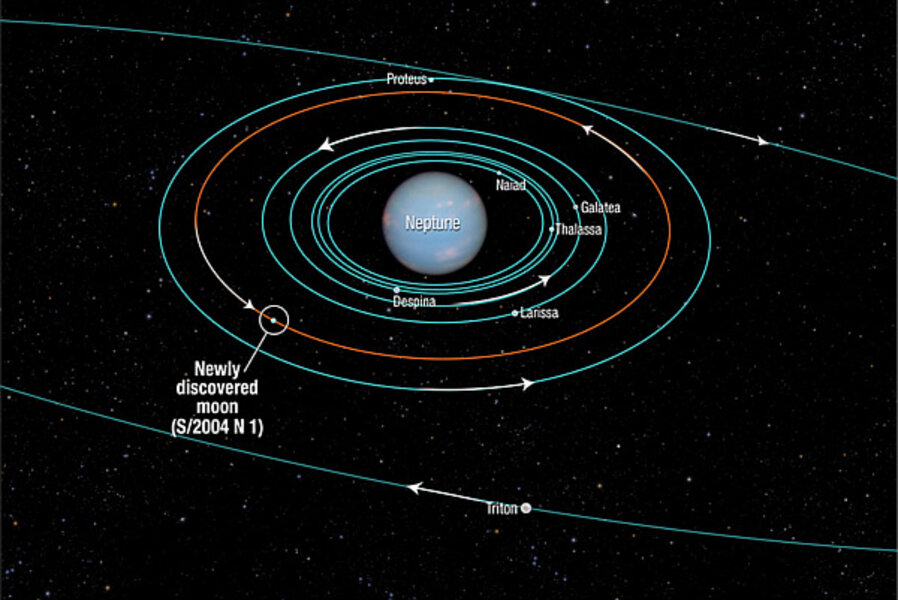Neptune moon: Tiny, dark, whizzing space ball captured on film (barely)
Loading...
Finding moons should be easy, right? Look how bright ours is, glowing away up there.
Except that our moon is (1) ridiculously close by, which makes it look bright, (2) ridiculously big, and (3) slow. Other moons like this – big, slow, bright – are relatively easy to find. Galileo spotted the four biggest moons of Jupiter back in the 17th century, using a telescope that worked about as well as a $50 pair of binoculars.
It's harder to find moons that don't follow this pattern. If they're small, or dark, it's much, much harder. Throw in fast – ridiculously fast – and it's no wonder that the most recently discovered moon of Neptune took years to find. This little planet, like a fidgety toddler, "never sits still long enough to have its picture taken," wrote Mark Showalter, the SETI researcher who discovered the tiny moon on July 1.
In fact, it travels over 350,000 miles in less than one Earth day, giving it a speed of about 15,000 miles per hour. It's not the fastest moon in the solar system – Metis, zipping around Jupiter three times a day, goes more than twice as fast – but it's still too fast to photograph easily.
The peppy little moon, currently identified only as S/2004 N 1, appeared in pictures taken by the Hubble Space Telescope between 2004 and 2009. But that's using "appeared" pretty generously. As Dr. Showalter wrote today, "We estimate that it is no more than 20 km across and as dark as if it were paved with dirty asphalt. Naturally, taking its picture requires long exposures. But there’s the rub. If you expose it for too long, the moon vanishes in a blur..." The size and color are both calculations, not measurements, so it's possible that the moon is brighter than asphalt, but that would mean that it's also smaller. So how do you find something small, dark, and fast?
Well, you don't depend on the human eye's ability to spot things. Our eyes are good at seeing color and motion, but they're terrible at seeing tiny, dark smudges against a black sky. So Showalter, a research scientist working on several NASA missions to the outer planets, wrote a computer program to help him comb through Hubble's 150 or so pictures of Neptune. "The procedure I devised predicts where any given moon ought to move from one image to the next," he writes, "and then combines the images with a 'twist' that compensates for the expected motion." He wasn't looking for a moon – after all, he didn't know there was a moon to look for – but developed the technique to examine some arcs in Neptune's rings, which are also nearly invisible.
Showalter has a proven knack for seeing the invisible. He has already discovered five other moons – Saturn's Pan, Uranus's Mab and Cupid, and Pluto's recently named Kerberos and Styx – as well as wispy gas rings around Jupiter, Uranus, and Neptune.
When it occurred to Showalter to use his software to look beyond Neptune's rings, this little moon appeared. And then again. In less than a week, it showed up ten times. He hasn't yet used this technique to look at other planets, but he plans to. "How much deeper could I go in the Hubble data sets?" he asks. "It seems like a promising question to look into."
Discovering a moon is cool enough. Among other things, it usually gives you naming rights, which Showalter exercised when he proposed the names for Pan, Mab, and Cupid to the International Astronomical Union (IAU). Showalter graciously opened the naming of Pluto's moons to the public, who voted overwhelmingly for Vulcan, though the IAU overruled them and selected the #2 and #3 vote-getters. Showalter hopes to involve the public in giving S/2004 N1 a better name, but he's still working out how. "I will say, I've already received suggestions via email, including some pretty good ones," he says.
And discovering this moon in particular raises some fascinating scientific questions. Astronomers thought they'd figured out the story of Neptune's moons, which focuses on the fact that the smaller moons are close in and the bigger moons are farther away from the gas giant. That story does not include having a small, dark rock, barely 12 miles across, whizzing madly out near the orbit of Neptune's bigger moons.
It might have something to do with Triton, Neptune's biggest – and oddest – moon. Triton is enormous – hundreds of times larger than any other moon of Neptune – and it orbits backward with respect to Neptune's own rotation and the orbit of all the other moons, like a car driving the wrong way up a highway. This tells astronomers that Triton wasn't originally part of Neptune's story, but got poached from somewhere else.
"We can be pretty sure that when Triton arrived, it disrupted whatever system of moons was originally circling Neptune," writes Showalter. "The moons that we see today somehow re-formed after that event. With the discovery of S/2004 N 1, the key points of this story have not changed, but we now have one more piece of the puzzle to fit into place."








